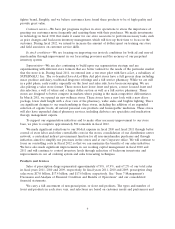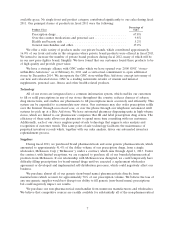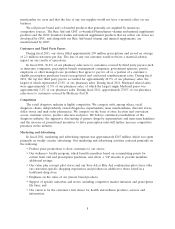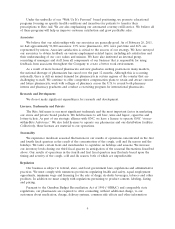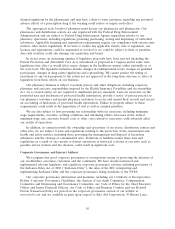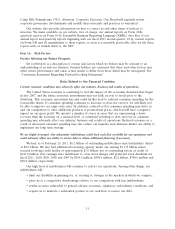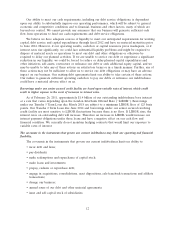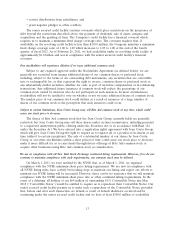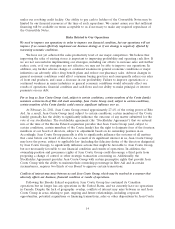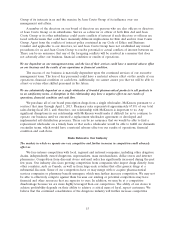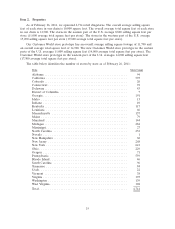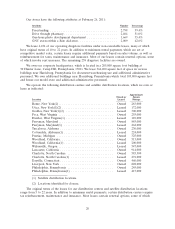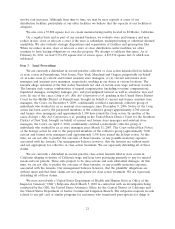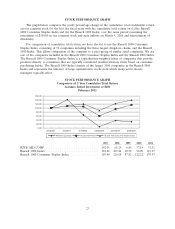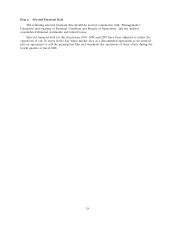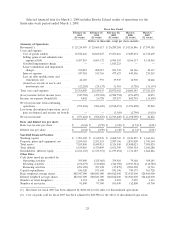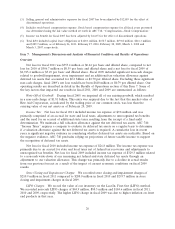Rite Aid 2011 Annual Report Download - page 16
Download and view the complete annual report
Please find page 16 of the 2011 Rite Aid annual report below. You can navigate through the pages in the report by either clicking on the pages listed below, or by using the keyword search tool below to find specific information within the annual report.pressures in the industry. We cannot assure you that we will be able to continue to effectively compete
in our markets or increase our sales volume in response to further increased competition.
Drug benefit plan sponsors and third party payors could change their plan eligibility criteria and further
encourage or require the use of mail-order prescriptions which could decrease our sales and reduce our
margins and have a material adverse effect on our business.
An adverse trend for drugstore retailing has been initiatives to contain rising healthcare costs
leading to the rapid growth in mail-order prescription processors. These prescription distribution
methods have grown in market share relative to drugstores as a result of the rapid rise in drug costs
experienced in recent years and are predicted to continue to rise. Mail-order prescription distribution
methods are perceived by employers and insurers as being less costly than traditional distribution
methods and are being encouraged, and, in some cases, required, by third party pharmacy benefit
managers, employers and unions that administer benefits. As a result, some labor unions and employers
are requiring, and others may encourage or require, that their members or employees obtain
medications from mail-order pharmacies which offer drug prescriptions at prices lower than we are able
to offer.
Another adverse trend for drugstore retailing has been for drug benefit plan sponsors and third
party payors to change their plan eligibility requirements resulting in fewer beneficiaries covered and a
reduction in the number of prescriptions allowed.
Mail-order prescription distribution and drug benefit plan eligibility changes have negatively
affected sales for traditional chain drug retailers, including us, and we expect such negative effect to
continue in the future. There can be no assurance that our efforts to offset the effects of mail order
and eligibility changes will be successful nor can we predict whether the recently adopted health care
reform legislation will exacerbate this risk.
The availability of pharmacy drugs is subject to governmental regulations.
The continued conversion of various prescription drugs, including the planned conversion of a
number of popular medications, to over-the-counter medications may reduce our pharmacy sales and
customers may seek to purchase such medications at non-pharmacy stores. Also, if the rate at which
new prescription drugs become available slows or if new prescription drugs that are introduced into the
market fail to achieve popularity, our pharmacy sales may be adversely affected. The withdrawal of
certain drugs from the market or concerns about the safety or effectiveness of certain drugs or negative
publicity surrounding certain categories of drugs may also have a negative effect on our pharmacy sales
or may cause shifts in our pharmacy or front end product mix.
Changes in third party reimbursement levels for prescription drugs and changes in industry pricing
benchmarks could reduce our margins and have a material adverse effect on our business.
Sales of prescription drugs reimbursed by third party payors, including the Medicare Part D plans
and state sponsored Medicaid agencies, represented 96.2% of our business in fiscal 2011.
The continued efforts of the Federal government, health maintenance organizations, managed care
organizations, pharmacy benefit management companies, other State and local government entities, and
other third-party payors to reduce prescription drug costs and pharmacy reimbursement rates, as well
as litigation relating to how drugs are priced, may impact our profitability. In addition, some of these
entities may offer pricing terms that we may not be willing to accept or otherwise restrict our
participation in their networks of pharmacy providers. Any significant loss of third-party business could
have a material adverse effect on our business and results of operations.
16


